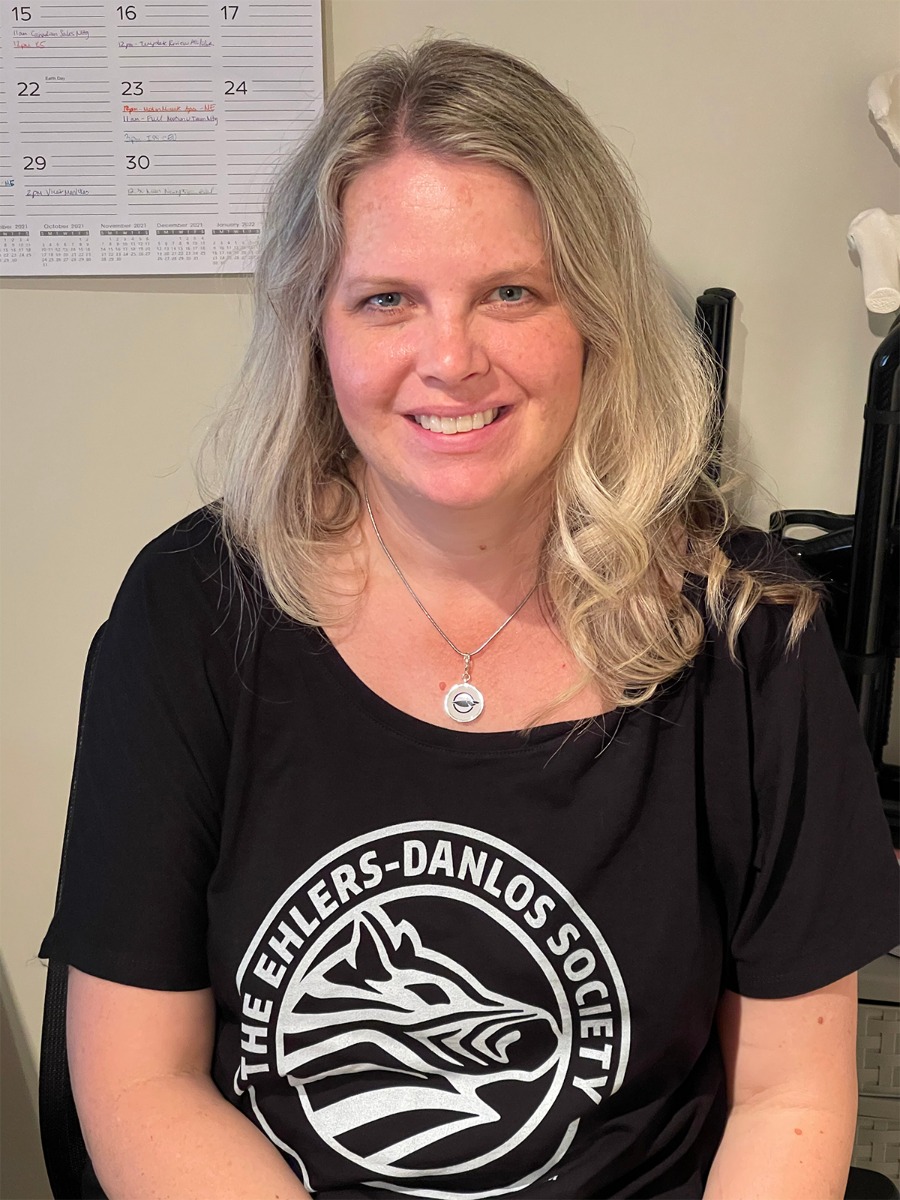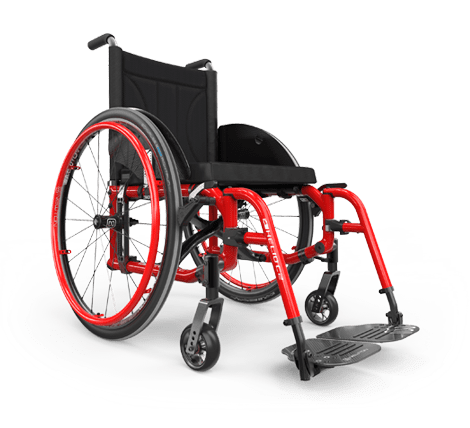My first introduction to Ehlers-Danlos Syndromes (EDS) was as a seating clinic therapist and for due diligence, I had to research what it was. Each client and family I met presented differently but often had similar paths leading them to a seating clinic. Quite often they had borrowed an old wheelchair from a church or community center or picked one up at a yard sale because without it they would be stuck at home, often in bed. Due to the many symptoms including weakness, muscle and joint pain, and chronic joint dislocations it was difficult to walk short or long distances when having “flare” days which often turn into weeks. While I personally saw several clients with EDS, the unfortunate truth is there are many more who do not know they can access seating clinics, complex rehab technology including a custom mobility device. The complexity of EDS and its unique and individual presentation is perplexing to many medical teams, and often complex rehab technology is not brought into intervention plans. This lack of understanding can lead many clients and family members left to research on their own in search of something more to increase accessibility for everyday life.
 The author, Education Specialist Christie Hamstra (DTP,PT, ATP).
The author, Education Specialist Christie Hamstra (DTP,PT, ATP).
Introduction to EDS
Ehlers-Danlos syndromes (EDS) are a group of inherited connective tissue disorders that share common features including joint hypermobility (joints that stretch further than normal), skin hyperextensibility (skin that stretches more than normal), excessive joint dislocations, easy bruising, and generalized fragility.1 These symptoms can range from none at all, where the individual doesn’t know they have the condition, to severely debilitating. There are currently 13 classified subtypes of EDS with prevalence anywhere from 1 in 2,500 to 1 in 5,000 people, with a higher incidence in women. Due to the impact this disease process has on connective tissue, there are physical manifestations beyond orthopedic, and can include vascular, gastrointestinal, and neurological involvement. This wide variety of symptoms and differences in presentations can be part of the reason a diagnosis can take years or even decades to identify. Each individual’s journey with EDS is unique, but many often share common frustrations over lack of knowledge and understanding about EDS within the healthcare community and the general public.
Often seen as invisible disability
Invisible disability is defined by Invisible Disabilities Association as a “physical, mental, or neurological condition that is not visible from the outside, yet can limit or challenge a person’s movements, senses or activities. Unfortunately, the very fact that these symptoms are invisible can lead to misunderstanding, false perceptions, and judgments.” Individuals with EDS share many stories of their symptoms and difficulties being written off as not “enough” of a disability, resulting in depression, despair, and apathy. Providing support with the proper medical team, including therapies and proper fitting and custom complex rehab technology, is ideal. To help this process along, more awareness and understanding of EDS symptoms and treatment strategies is vital.
Challenges with mobility
Because of the underlying etiology of EDS as a connective tissue disorder, mobility challenges can be an extremely frustrating and debilitating presentation. Henderson Sr et al discussed that “musculoskeletal pain starts early, is chronic and debilitating, and the neuromuscular disease of EDS manifests symptomatically with weakness, myalgia, easy fatigability, limited walking, reduction of vibration sense, and mild impairment of mobility and daily activities.”2 The combination of orthopedic and neuromuscular symptoms, depending on their severity can lead to limited ability for independent, pain-free and functional mobility. For some individuals the lead-up to needing mobility assistance is gradual. They may start with a cane, crutches, or a walker, and then transition to a wheelchair. It often takes a while to access a seating clinic team to prescribe a custom device to meet their specific needs.
Justifications for Complex Rehab Equipment
While it may seem obvious that a custom ultralightweight manual wheelchair or even a power chair is indicated and medically necessary based on the individual’s symptoms and presentation, it is often a challenge to document. Here we will look at documenting for a custom ultralightweight manual wheelchair and medical justifications to meet coverage criteria for a potential client with EDS (we suggest you contact your clinial supplier for more information on funding in your area).
Establish the Medical Need
First, the therapist must establish the medical need for the requested equipment and rule out lesser costly alternatives such as a cane, walker, crutches, or a non-custom wheelchair. Most often, because the presentation of EDS includes joint hypermobility, frequent dislocations, muscle weakness and pain, ruling out canes, walkers, or crutches as previously tried and not the most medically appropriate for full functional mobility, then the features of the ultralightweight custom manual wheelchair can be justified.
Providing evidence of both musculoskeletal and neuromuscular involvement in EDS can help to paint the justification picture. Henderson Sr et al discusses the neuromuscular features of EDS, including myalgia (pain in a muscle or group of muscles), hypotonia (abnormally low level of muscle tone), progressive muscle weakness, and poorly developed musculature. These evidence-based medical symptoms can be tied to lack of functional mobility for individuals with EDS. Additional neuromuscular features discussed include easy fatigability, limited walking distance and reduction in vibration sense, which can contribute to limited mobility and other activities of daily living.
Rombaut et al discussed muscle mass, muscle strength and functional performance along with the same functional mobility impairments, but also increased risk of falling due to the weakness, increased fatigue, longer recovery time, pain, and muscle dysfunction. 3 They even suggested supportive aides including crutches or a wheelchair may appeal to individuals with EDS for improving mobility and therefore quality of life.
Individuals with EDS may not even know these manifestations are medical justifications for complex rehab and a custom wheelchair. As the clinician it is our job to observe and ask about these symptoms in a way to ensure we can paint the whole clinical picture. Katryna Kofton, a young lady of 26 who was diagnosed with EDS in 2018 says, “I just thought EVERYONE dealt with horrid pain and having a ‘dead leg’ making it both difficulty and painful to walk, leaving me not able to do many things I wanted to as a teenager. I was told it was growing pains, and there’s no way I could have any rare disease and to just deal with it.” As horrifying as Katryna’s experience is, it is more common than not for individuals with EDS.
As you can see from the evidence, there are many ways your client can be affected by EDS and identifying specifically how it manifests with them will help identify the specific need for equipment and how to justify it.
Justifying it
When writing justifications for any custom ultralightweight manual wheelchair, specific instances of the presentation of the individual must be linked to the features of the selected equipment that are not available on a lower-level model. With any custom manual ultralightweight wheelchair knowing and understanding all available options will help the individual and team make the best choice to fit current and future goals and lifestyle. A big factor for individuals with EDS is weight and configuration of the system, not just for propulsion but for transfers and overall use.
Weight on a wheelchair is dictated by frame style, material, and components and accessories selected for the chair, including seating. With EDS every ounce of weight makes a difference in function. Pain, fatigue, and dislocations are common, and keeping the overall weight of a system down can help to prevent additional injury while maintaining the highest level of function for the individual. When selecting the frame style, folding and rigid wheelchairs each has a design feature that can benefit an individual. However, a rigid frame will be lighter and will have more ability to dial in custom fit.
Common ultralightweight wheelchair materials include aluminum, titanium, and carbon fiber; These materials have different properties related to weight, strength, and durability. Selecting the right material will have a significant impact on overall performance. Carbon fiber is the lightest material and has the highest strength to weight ratio, making it strong and durable and an ideal choice for manual wheelchair design. Gebrosky et al writes, “the low weight of carbon fiber wheelchairs may increase the mobility of some users by allowing them to transfer more easily into and out of vehicles and maneuver throughout the environment.”4
Be aware of added accessories and components. Knowing and understanding the purpose behind each item on the chair as well as the impact on overall weight is important. Selecting lighter weight seating devices, footplate, or armrest will help keep overall weight of the system down. Rear wheel and tire selection can also make a huge impact on weight, performance, and independence. Looking at individual wheelchair components and how they work together will make a significant impact on outcomes for the individual with EDS.
In addition to selecting lightweight materials and accessories proper set up must be used in conjunction to maximize overall performance. The most common example for justification is an adjustable rear axle. Any individual with EDS utilizing a manual wheelchair for independent mobility should have the ability to move the axle to fit their body for efficient propulsion and to prevent further pain and injury. Moving the rear wheel as far forward as possible without making the chair too tippy will allow for optimum propulsion and decrease stress and strain on the shoulder joints while maintaining safety. Built in rear axle adjustability will allow for fine-tuning of fit and function and continuation of the ideal set up throughout the constant fluctuation of EDS presentation.
There are many other components which can be justified specifically to an individual with EDS. No matter how your client presents, by using the medical evidence and how it affects the individual user you can match the specific limitations to the requested equipment. This will ensure the individual has the best chance of access to funding through traditional means.
Rare Disorder Education and Awareness
Individuals with EDS identify with the uniqueness of a zebra. While the zebras all have stripes, no two are the same. According to the Ehlers Danlos Society “Medical students have been taught for decades that, ‘when you hear hoofbeats behind you, don’t expect to see a zebra.” Except in the case of EDS, sometimes it is a zebra, as individuals with rare and invisible disorders are often written off for years while searching for answers. Check out this awareness video.
If you are interested in reading testimonials of other users who utilize Motion Composites carbon fiber manual wheelchairs, you can read interviews we did with Dr. Mitchell Tepper, and Pete Anziano
If you are interested in a Motion Composites manual wheelchair, visit our product section.
REFERENCES
- EDS and HSD Info. (2021, February 15). The Ehlers Danlos Society. https://www.ehlers-danlos.com/ehlers-danlos-info/
- Henderson, F. C., Austin, C., Benzel, E., Bolognese, P., Ellenbogen, R., Francomano, C. A., Ireton, C., Klinge, P., Koby, M., Long, D., Patel, S., Singman, E. L., & Voermans, N. C. (2017). Neurological and spinal manifestations of the Ehlers-Danlos syndromes. American Journal of Medical Genetics Part C: Seminars in Medical Genetics, 175 (1), 195—211. https://doi.org/10.1002/ajmg.c.31549
- Rombaut, L., Malfait, F., De Wandele, I., Taes, Y., Thijs, Y., De Paepe, A., & Calders, P. (2012). Muscle mass, muscle strength, functional performance, and physical impairment in women with the hypermobility type of Ehlers-Danlos syndrome. Arthritis Care & Research, 64(10), 1584–1592. https://doi.org/10.1002/acr.21726
- Gebrosky, B., Grindle, G., Cooper, R., & Cooper, R. (2019). Comparison of carbon fiber and aluminum materials in the construction of ultralight wheelchairs. Disability and Rehabilitation: Assistive Technology, 15(4), 432–441. https://doi.org/10.1080/17483107.2019.1587018







 The author, Education Specialist Christie Hamstra (DTP,PT, ATP).
The author, Education Specialist Christie Hamstra (DTP,PT, ATP).